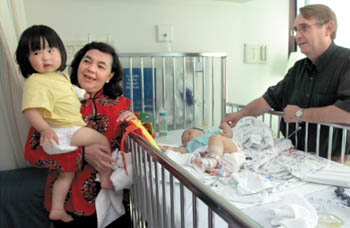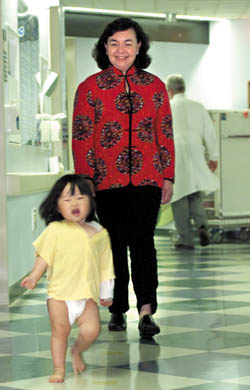
Joyce and Robin Hill brought 20-month-old Lin Lin Gong and 9-month-old Jiali Guo to the United States for surgery. The two Chinese girls were orphaned because of their physical abnormalities. (photo by Dana Johnson)
A voyage for the future —
Chinese foster girls receive surgeries, new chances

No stopping her now. Lin Lin, now named Kaitlyn, runs the halls of Vanderbilt Children’s Hospital only days after her surgery. (photo by Dana Johnson)
It might seem their lives were without fairy tale beginnings, as all little girls would hope for. But thanks to a British couple, and their voyage halfway around the globe to Vanderbilt University Hospital, the plots in their respective stories have taken a happier turn.
Twenty-month-old Lin Lin Gong and 9-month-old Jiali Guo were orphaned in Beijing, China, shortly after their births. Like many babies, especially girls, and especially babies with physical abnormalities – Lin Lin had a hump on her shoulder, Jiali one in the middle of her back – Lin Lin and later Jiali were found by Beijing police and taken to a state-run orphanage. There, their ages were approximated, first and last names were doled out, and they joined the ranks of the estimated millions of abandoned children in China.
Then, one day, British doctor Joyce Hill and her husband Robin Hill went to the orphanage looking for girls just like these two to adopt. The Hills went to Beijing in 1995. Robin had accepted a two-year stint there with his engineering firm. The couple decided to stay, they say, because they felt called to help the children. They decided to open Hope Foster Home, and with Joyce’s medical background – she’s a primary care doctor – they decided to gather girls with correctable physical abnormalities, embracing a particular, largely unmet, need. That was more than a year ago, and Lin Lin was the first girl they adopted.
“I went to the orphanage and asked for a child under 6 months of age,” remembers Joyce, a determined, cherubic woman with seven children of her own – three from a previous marriage, Robin’s three from his previous marriage and one from the couple’s union. “They said they had a child, about 5 months old, with a hump on her left shoulder.”
Chinese doctors, she learned, thought the child had spina bifida, a deformity that can leave a child unable to walk and can come with a host of complications. Lin Lin, a bright-eyed girl with the energy of a dragonfly, was their first Chinese baby. They named her Kaitlyn.
Several months later it was time to scoop up into their arms another orphaned girl. Jiali, now named Molly, “was lying on her front, and she looked at me with this serious look on her face,” Joyce recalls. “She just watched me all the time.” And so Molly, who appears to loll about while her round dark eyes soak up the world studiously, joined Hope Foster Home.
But then the search began for medical care for Kaitlyn and Molly. The Chinese government first denied the Hills’ request to seek medical care outside the country. But, Robin says, the relationship with the state-run orphanage changed dramatically, and they were granted permission to come to the United States. For months, they searched for a temporary medical home. A March update on the Hope Web site, newdaycreations.com, relates their frustrations: “The last month has been a difficult one for us …Molly and Kaitlyn are still waiting for a positive response from a hospital in the USA. We have tried over 20 avenues and are still searching. The problem being mainly with the hospitals who are not willing to accept ‘charity cases’ at a reduced cost.”
The Hills didn’t name their home Hope accidentally. In April, their Internet update read: “We have wonderful news, especially for those who have supported us in so many ways in our long wait to take Molly and Kaitlyn to the USA for surgery. Their surgeries are scheduled for the first week of May at Vanderbilt Hospital, Nashville, Tennessee.”
The Hills had been in e-mail contact with a family in Florida whose child had spina bifida surgery here. That family put the Hills in touch with Dr. Noel B. Tulipan, professor of Neurological Surgery, who agreed to see Kaitlyn and Molly. Hospital administrators worked out some details with the Hills, and friends with Northwest Airlines helped raise funds for the surgeries and provided transportation to Nashville.
On May 1, Kaitlyn and Molly were in Tulipan’s clinic in Medical Center East, 6,993 miles west of their homeland. Kaitlyn, it turned out, did not have a spinal defect, as Chinese officials presumed. The lump was a cystic hygroma – a lymphangioma, a malformation of the lymphatic vessels. Tulipan recommended her surgery be performed by Dr. John B. Pietsch, associate professor of Pediatric Surgery.
“The simplistic explanation would be that the lymphatic system gets backed up into a lake or a reservoir. Lymphatic fluid gets into these structures and doesn’t get out,” Pietsch said of Kaitlyn’s malformation. The surgery was “moderately difficult,” he said, because of the location in her neck and shoulder area. The day after the surgery, she was running around Children’s Hospital, acquainting herself with staff and other patients, showing not only boundless energy, but also incredible resolve. “The only problem is she’s almost too active,” Pietsch said.
Molly, as Joyce suspected, had a myelomeningocele. Her spine had split open, leaving the spinal cord exposed, and bone spurs grew like a cliff’s rocky crag from the vertebrae at the upper end of the split. Tulipan and neurosurgery resident Dr. Jeff Albea carefully removed the fat and flesh that had grown around the spur and formed the lump, and then the bits and pieces of the spur. Finally, they sewed a tough synthetic dura over the spinal cord, covered that with a flap of flesh, and closed Molly’s incision, leaving her back flat.
Patients like Molly, who receive surgery like that provided by Tulipan, typically recover well. “They can grow normally,” Tulipan said. The back part of the vertebrae, where the rip occurred, offers little structural support, he said, and the rib cage further supports the trunk.
The Vander-bilt surgeons say their part in this tale is minimal. They were doing their jobs, although their fees were waived. The larger story, they say, is about the determination and love of the Hills taking on such a huge task.
The Hills view it differently. Their part, too, is one they were called to do. “The choice to be in China was not ours,” Joyce said. “The choice was to obey “ a calling as Christians.
With millions of orphans around the world, Robin says people from time to time mention the vast challenge of caring for them all and question the couple’s impact.
“It’s like the story of the starfish,” said Robin, holding Kaitlyn in his arms. “There was a man who walked along the beach, picking up starfish and throwing them back into the ocean. Another man came along and asked him, ‘Do you think you’re really making a difference?’ And the first man told him, as he picked up another starfish, ‘It makes a difference to that one.’
“We can’t solve the whole problem,” Robin said. “But we can make a difference.” Now the Hills have 11 foster children.
The Hills recently began their trek back to China, with Molly and Kaitlyn and their newly repaired bodies. The girls were oblivious to their plight, and now are just as unknowing about their rescue. But one day, when they’re old enough to realize what they faced, and how a couple of strangers picked them up and took them halfway around the world to even more strangers, they’ll realize their story was perhaps a fairy tale. And they can begin their stories.













